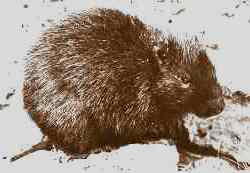Cabrera tree rat
| Cabrera tree rat | ||||||||||||
|---|---|---|---|---|---|---|---|---|---|---|---|---|

Cabrera tree rat ( Mesocapromys angelcabrerai ) |
||||||||||||
| Systematics | ||||||||||||
|
||||||||||||
| Scientific name | ||||||||||||
| Mesocapromys angelcabrerai | ||||||||||||
| ( Varona , 1979) |
The Cabrera tree rat ( Mesocapromys angelcabrerai ) is an endangered species of tree rats that, like the other representatives of this genus , is restricted to Cuba . The total number of these rodents is distributed across several small islands off the southern coast of Cuba. Little is known about the way of life of the Cabrera tree rat.
Appearance
The animals are 60 to 90 centimeters tall and have broad heads with narrow, small eyes. They have a short brown to gray fur and a soft short undercoat, which covers the whole body and the long tail. The legs are short.
Anatomical peculiarities
They differ from all other rodents because of their stomach, which is divided into three chambers.
Habitat and Discovery
The Cabrera tree rat occurs only in the mangrove forests of the Cayos de Ana María island chain , which is off the island of Cuba in the south. On the Cuban main island itself, it was discovered near the port city of Júcaro (Júcaro Este), where two specimens were found for the first time in 1970. Since then, there have been no further reports of observations or catches of this type from there.
Way of life
The Cabrera tree rats feed on parts of plants and smaller animals that they find on the mangroves in their habitat. In the mangrove trees, mainly the red mangrove , they build their nests with a diameter of around one meter and several entrances and exits. Little is known about the further way of life and reproduction of these nocturnal animals. Natural enemies include snakes and birds of prey .
Hazards and protective measures
The species is endangered by the destruction of its habitat, by hunting and by the dogs, cats and mongooses introduced by humans . It is possible that the introduced black rat ( Rattus rattus ) also represents competition for the Cabrera tree rat. The IUCN classifies this species as Endangered (endangered) due to its very small distribution area . A nature reserve was set up on the Cayos de Ana María island chain to protect the species.
Related species
The related long-eared tree rats ( Mesocapromys auritus ), the dwarf tree rat ( Mesocapromys nanus ) and the San Felipe tree rat ( Mesocapromys sanfelipensis ) also live in Cuba. The latter two are critically endangered. In the caves on Cuba and their smaller offshore islands, the remains of other extinct species of the genus Mesocapromys were found in the rubbish heaps around the hearths of the island's first human settlers .
Individual evidence
- ↑ Distribution area on the IUCN map
literature
- David MacDonald (ed.): Enzyklopädie der Säugetiere , Könemann, 2003 ISBN 3-89731-928-4 , pp. 682-685.
- Evžen Kůs; Václav Pfleger (Czech): Rare and threatened animals. German translation by Peter Zieschang, Verlag Gondrom, 2001 ISBN 3-8112-1830-1 , p. 50.
- Miloš Anděra (Czech): Endangered animals. German translation by Günter Brehmer, Verlag Dausien, Hanau 1998 ISBN 3-7684-2800-1 , pp. 89-90
Web links
- Mesocapromys angelcabrerai inthe IUCN Red List of Threatened Species 2012.2. Posted by: Soy, J. & Silva, G., 2008. Retrieved May 22, 2013.